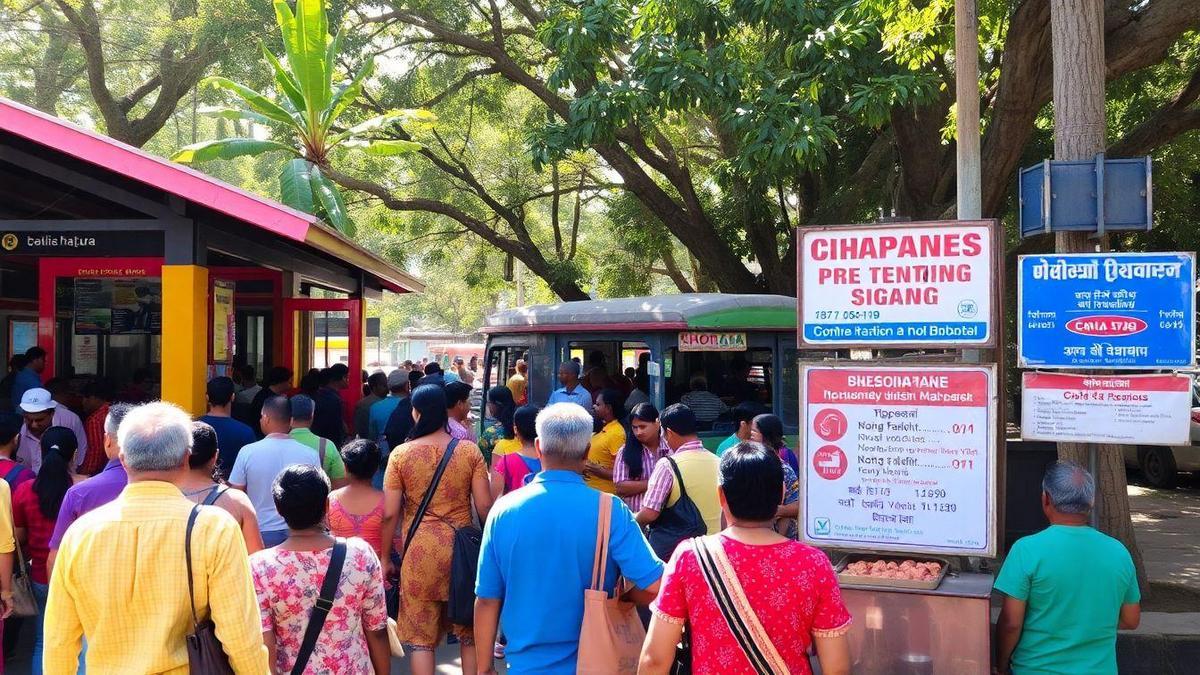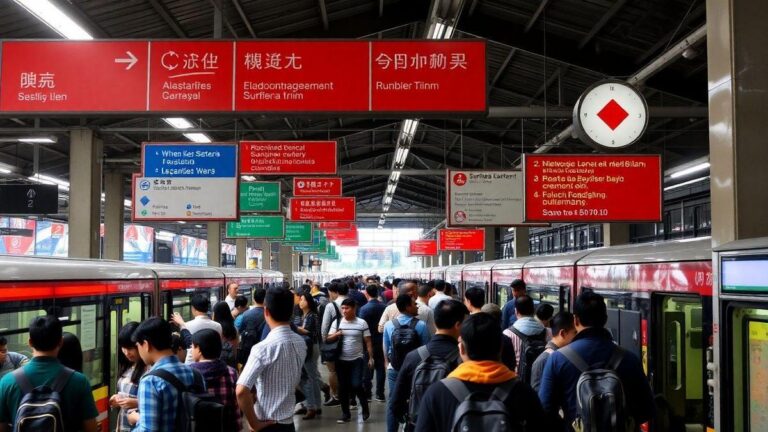Public transportation tips influenced by language abilities in developing areas
Public transportation tips influenced by language abilities in developing areas can change the way you travel. When you’re hopping on a bus or a train, being ready to tackle language barriers makes your trip smoother! This article will help you understand local dialects, master key phrases, and find handy multilingual resources. Get ready to connect with transit staff and local communities, so you can enjoy every adventure in a new place! Let’s dive in!
Important Points to Remember
- Know basic local phrases for help.
- Use maps or apps to find your way.
- Ask locals for advice on transport.
- Travel in groups for safety.
- Be patient and stay calm during delays.
Overcoming Language Barriers in Public Transportation
Understanding Local Dialects and Languages
When you hop on public transport in a new area, language differences can feel like a brick wall. Each region often has its own dialects and phrases. For example, in some places, “bus” might be called “colectivo” or “guagua.” Learning a few local words can be a game-changer! It helps you connect with the locals and feel more at home.
Here are some quick tips to get started:
- Learn Basic Phrases: Start with greetings like “hello,” “thank you,” and “where is the bus station?”
- Listen and Observe: Pay attention to how locals communicate. You might pick up on common terms or phrases.
- Practice Makes Perfect: Don’t be shy! Try speaking with locals. Most people appreciate the effort.
Tips for Communicating with Transit Staff
When you’re in a pinch, transit staff can be your best friends. Here are some handy tips for chatting with them:
- Be Polite: A smile and a simple “excuse me” can go a long way.
- Use Simple English: If you’re not sure about the local language, stick to basic English words. Keep it short and clear.
- Point It Out: If you have a map or a bus schedule, point to where you want to go. Visuals can help bridge the gap.
Using Translation Apps for Easy Navigation
In today’s tech-savvy world, translation apps are your trusty sidekicks. They can help you get around with ease. Here’s a quick table to showcase some popular options:
| App Name | Features | Cost |
|---|---|---|
| Google Translate | Text, voice, and camera translation | Free |
| iTranslate | Voice translation and dictionary features | Free/Premium |
| Microsoft Translator | Text and voice translation, offline mode | Free |
These apps can help you read signs, ask for directions, and understand announcements. Just download one before your trip, and you’ll be set!
Enhancing Your Travel Experience with Multilingual Resources
Finding Multilingual Signage in Transit Areas
When you’re traveling, multilingual signage in transit areas can be a lifesaver. Imagine stepping off a bus in a foreign city and seeing signs in your language. It makes everything feel less overwhelming. Look for signs that offer information in multiple languages, especially at airports and train stations. These can help you navigate without the hassle of language barriers.
Here’s a quick tip: Always keep your eyes peeled for symbols and icons as they often convey messages universally. For example, a suitcase icon usually means luggage, and a train icon means the train station.
Utilizing Bilingual Maps and Guides
Bilingual maps and guides can turn your travel experience from confusing to enjoyable. They provide directions in your language and help you discover local attractions without getting lost in translation. Many tourist information centers offer free bilingual maps. Grab one as soon as you arrive!
Here’s a simple table showing the benefits of using bilingual maps:
| Benefits | Description |
|---|---|
| Easy Navigation | Follow directions in your language with ease. |
| Cultural Insights | Learn about local attractions and their significance. |
| Enhanced Communication | Share your map with locals for better assistance. |
The Importance of Public Transport Education for Travelers
Understanding how to use public transport is crucial, especially in developing areas. Public transportation tips influenced by language abilities can make a significant difference. For instance, if you know basic phrases like “Where is the bus station?” in the local language, it can help you ask for directions more confidently.
Take a moment to learn a few key phrases before your trip. It can be as simple as “Hello,” “Thank you,” and “Where is…?” This small effort can open doors and create a friendly atmosphere. Remember, locals appreciate when you try to speak their language!
Building Cultural Navigation Skills for Effective Commuting
Learning Key Phrases for Everyday Travel
When you’re traveling, knowing a few key phrases can make a world of difference. Imagine stepping into a bustling market or hopping on a bus. With just a bit of local language, you can ask for directions, order food, or greet someone with a friendly smile. Here are some handy phrases to get you started:
- Hello – A simple greeting goes a long way.
- Thank you – Showing gratitude is always appreciated.
- Where is…? – Perfect for asking about locations.
- How much is this? – Useful for shopping.
By learning these phrases, you’re not just speaking; you’re connecting with the culture. It’s like having a key that opens doors to new experiences.
Engaging with Local Communities for Better Insights
Engaging with the locals can give you a better understanding of the area you’re in. Think of it as diving into the rich tapestry of the community. Attend local events, visit neighborhood cafes, or join group activities. Here are some ways to connect:
- Volunteer – Helping out can lead to friendships and insights.
- Join local tours – Guides often share stories that you won’t find in any book.
- Participate in workshops – Learn a craft or skill from locals.
By immersing yourself in these activities, you’ll not only learn more about the culture but also make lasting memories. It’s like finding hidden treasures in a treasure hunt!
How Language Skills Improve Accessibility in Transit
Language skills can greatly improve how you navigate public transportation. When you understand the local language, you can read signs, ask for help, and communicate with drivers. This makes traveling smoother and less stressful. Here’s how language abilities can help:
| Language Skill | Benefit |
|---|---|
| Understanding directions | You can find your way without getting lost. |
| Asking for help | Locals can assist you when you need it. |
| Reading schedules | Knowing when your bus or train arrives is key. |
By enhancing your language skills, you’ll feel more confident and empowered during your travels. It’s like having a secret map that guides you through the twists and turns of public transport.
Frequently Asked Questions
How can knowing the local language help with public transportation?
Knowing the local language helps you understand signs and directions. This makes finding your way much easier. It also helps if you need to ask for help.
What if I don’t speak the local language?
Don’t worry! Use simple phrases or gestures. Many people will try to help you. You can also use translation apps on your phone for quick phrases.
Are there translation apps for public transportation?
Yes! Apps like Google Translate are great for translating signs and questions. They can help you navigate public transportation in developing areas.
What are some public transportation tips influenced by language abilities in developing areas?
Learn key phrases like Where is… or How much is… This makes travel smoother. It also builds confidence when using public transport.
How can I prepare for public transportation in a new language?
Do some research before you go. Look up common phrases. Familiarize yourself with transportation maps and routes. This will help you feel more ready and relaxed.

Hey, I’m Paula — traveler, language nerd, and the curious mind behind znewz.com. I’ve always believed that real connections happen through words, gestures, and shared experiences — not algorithms. That’s why I created this blog: to share travel stories from around the world and explore how language helps us connect in ways that AI still can’t. Whether I’m getting lost in a tiny town or striking up a chat in a language I barely know, I’m here to show that sometimes the best moments happen when tech takes a back seat.






